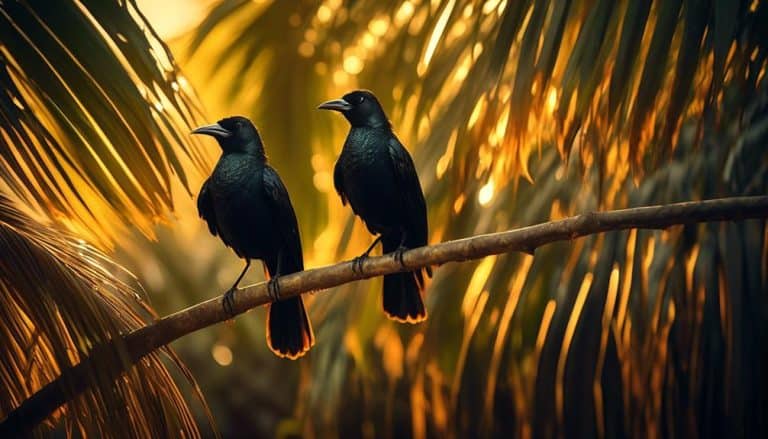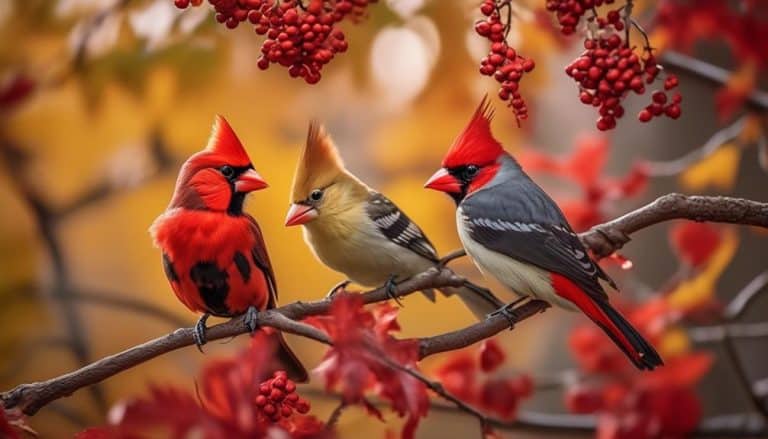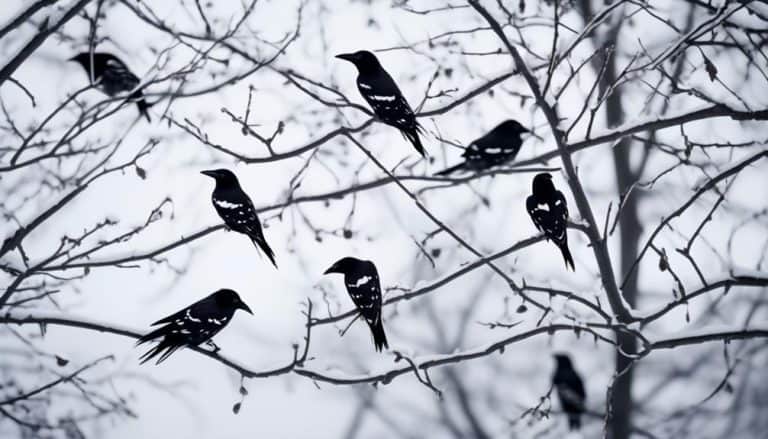As I walked along the peaceful trails of Iowa's prairie, a flash of wings caught my attention. It was a striking male Eastern Bluebird, its vibrant blue feathers contrasting beautifully against the golden hues of the surrounding grasses.
This encounter sparked my curiosity about the diverse avian species that call Iowa home. From regal raptors to delicate songbirds, Iowa's skies are a haven for a wide array of fascinating birds.
Join me as we explore the extraordinary world of birds in Iowa, uncovering their unique behaviors, stunning plumage, and the vital role they play in our ecosystem.
Bald Eagle: Iowa's Majestic Raptor
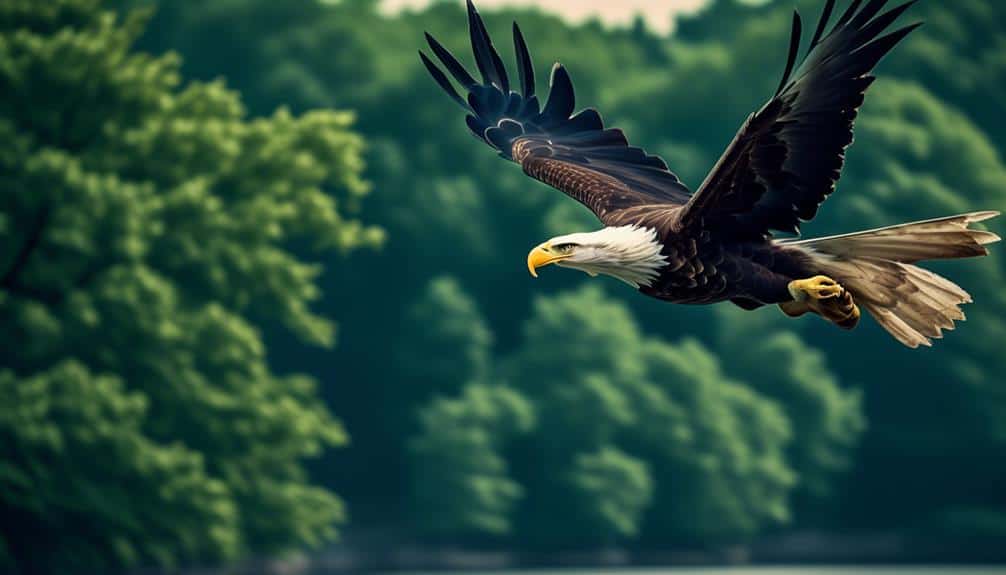
The Bald Eagle, Iowa's majestic raptor, is a formidable and awe-inspiring bird that dominates the skies with its impressive wingspan and piercing gaze. As a symbol of strength and freedom, the bald eagle holds a special place in the hearts of Iowans.
Over the years, Iowa's bald eagle population has faced numerous challenges, including habitat loss, pollution, and illegal hunting. However, thanks to dedicated conservation efforts, the population has rebounded significantly.
Conservation organizations, such as the Iowa Department of Natural Resources and the U.S. Fish and Wildlife Service, have played a crucial role in protecting and restoring bald eagle habitats throughout the state. These efforts have included creating protected areas, removing harmful pollutants from water sources, and educating the public about the importance of preserving these magnificent birds.
The impact of bald eagles on Iowa's ecosystem can't be overstated. As apex predators, they help regulate populations of prey species, such as fish and waterfowl. Additionally, their nesting activities create habitats for other bird species and contribute to the overall biodiversity of the region.
Eastern Bluebird: A Splash of Color in Iowa's Skies
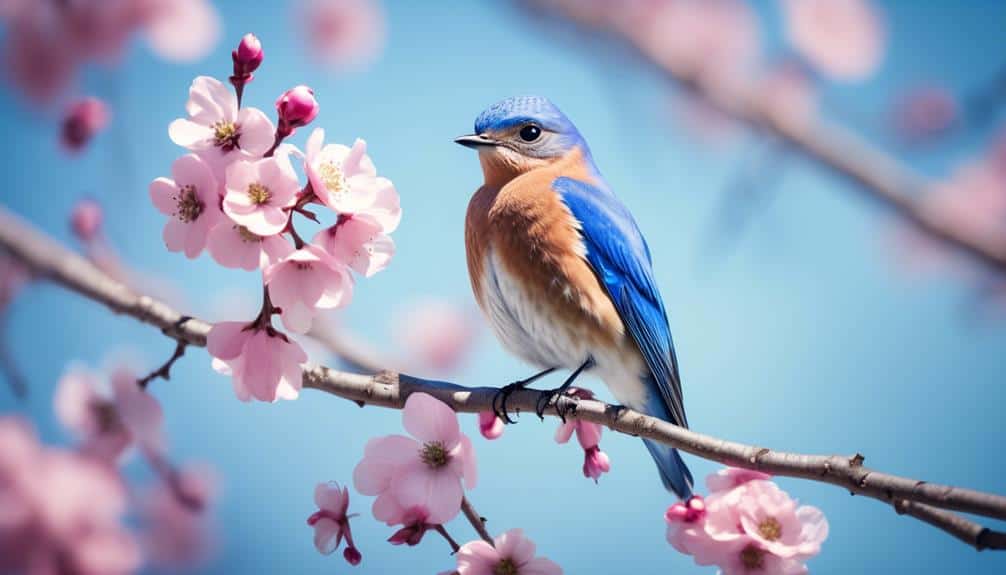
With its vibrant blue plumage and melodious song, the Eastern Bluebird adds a burst of color and enchanting music to the skies of Iowa. As I observe these beautiful birds in their natural habitat, I'm fascinated by their conservation efforts and unique nesting habits. Here are four intriguing facts about Eastern Bluebirds in Iowa:
- Eastern Bluebird conservation: These stunning birds have faced challenges in recent years due to habitat loss and competition from non-native species. However, thanks to conservation efforts and the installation of nest boxes, their populations have rebounded in Iowa. It's heartening to see the community come together to protect these avian treasures.
- Nesting habits: Eastern Bluebirds are cavity nesters, meaning they build their nests in natural tree cavities or man-made nest boxes. They prefer open areas with short grass or meadows adjacent to woodlands, where they can easily find insects for their diet. It's crucial to provide suitable nesting sites to support their breeding success.
- Nest box monitoring: Conservation organizations and volunteers play a vital role in monitoring nest boxes. They regularly check the boxes for occupancy, nest condition, and any signs of predators or parasites. This monitoring helps ensure the survival of Eastern Bluebird chicks and allows scientists to gather valuable data on their population dynamics.
- Brood parasitism: Eastern Bluebirds are sometimes targeted by brood parasites like Brown-headed Cowbirds. These cowbirds lay their eggs in the bluebird nests, leaving the bluebird parents to raise their young. Nest box monitoring helps identify and remove cowbird eggs, protecting the bluebirds' offspring from this parasitic behavior.
As I continue to observe Eastern Bluebirds in Iowa, I'm inspired by their resilience and the dedicated efforts to conserve their populations. These captivating birds remind us of the importance of preserving and protecting our natural habitats for future generations to enjoy.
Northern Saw-whet Owl: The Silent Night Hunter
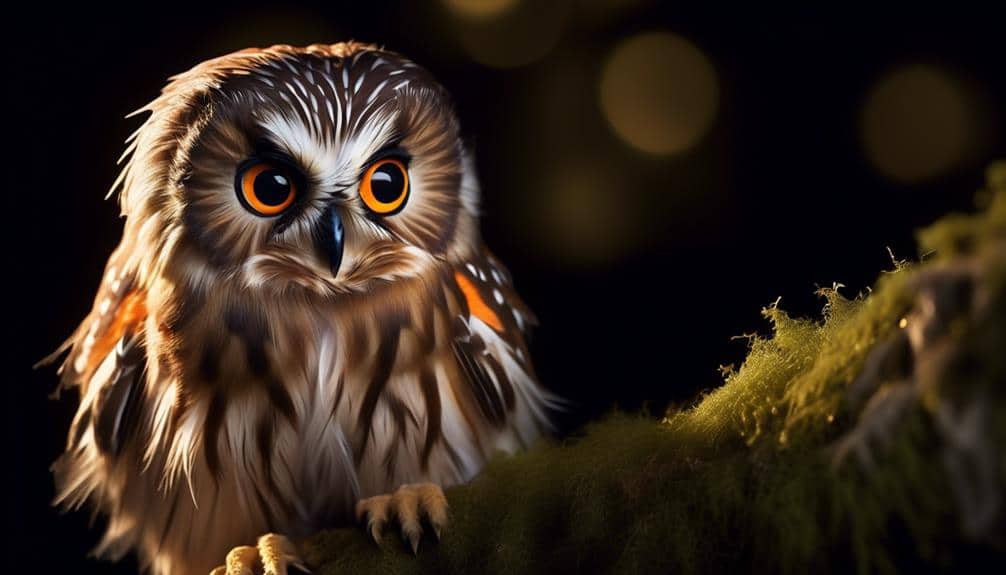
As I shift my focus from the vibrant blue plumage of the Eastern Bluebird, my attention is drawn to the Northern Saw-whet Owl, a master of the night skies with its stealthy hunting techniques. The Northern Saw-whet Owl, known as a silent night hunter, is one of Iowa's nocturnal predators. With its small size and cryptic plumage, it blends seamlessly into the dense forests, becoming nearly invisible to its prey. This small owl possesses exceptional hearing capabilities, allowing it to locate its prey with precision in the dark of the night.
The Northern Saw-whet Owl's diet primarily consists of small mammals, such as mice, voles, and shrews. It silently swoops down from its perch, using its keen eyesight to spot its prey before swiftly snatching it with its sharp talons. Its hunting technique is so efficient and silent that its prey often has no time to react before becoming a meal.
To further enhance its stealth, the Northern Saw-whet Owl possesses specialized feathers that reduce noise during flight. This adaptation allows it to approach its prey undetected, making it a formidable predator in the night.
As I observe this magnificent creature, I'm reminded of the intricate balance of nature. The Northern Saw-whet Owl, with its silent night hunting skills, plays a vital role in controlling the populations of small mammals, providing a crucial service within Iowa's ecosystem.
American Goldfinch: Iowa's State Bird
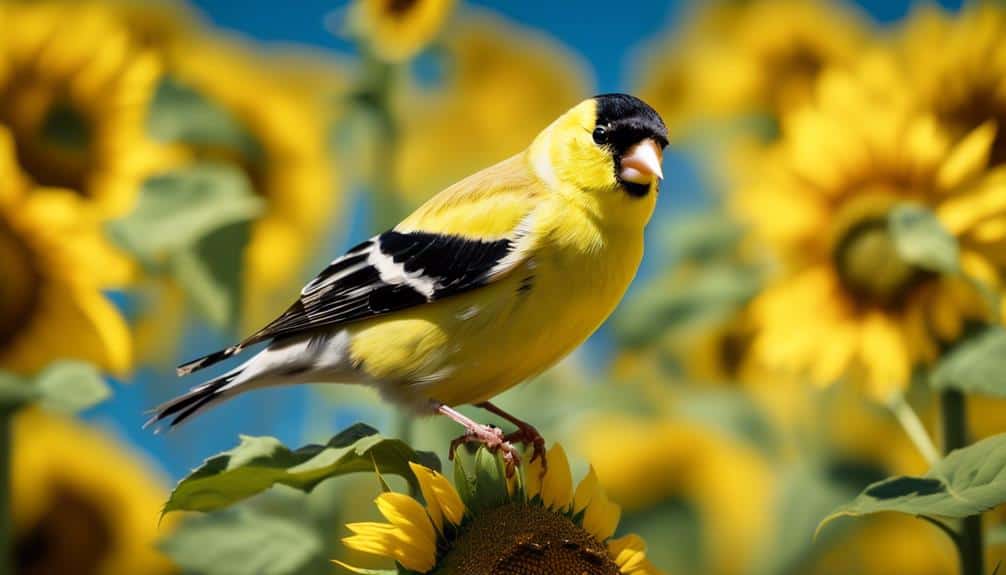
I am captivated by the vibrant yellow plumage of the American Goldfinch, Iowa's state bird, as it flits gracefully through the meadows and woodlands. This delightful little bird, scientifically known as Spinus tristis, has a unique habitat and diet that contribute to its charming presence in the Hawkeye State.
Habitat: American Goldfinches are primarily found in open areas with scattered trees, such as meadows, fields, and orchards. They also inhabit shrubby areas and woodland edges. Their preference for open spaces allows them to easily access their preferred food sources.
Diet: These finches have a specialized diet that mainly consists of seeds. They've a particular fondness for the seeds of thistles, sunflowers, and dandelions. Unlike many other songbirds, American Goldfinches feed their young exclusively on regurgitated seeds, providing a high-energy diet rich in nutrients.
Conservation Efforts: To safeguard the future of Iowa's state bird, conservation initiatives have been put in place. These efforts focus on preserving and restoring the natural habitats that the goldfinches rely on, as well as providing supplemental food sources during harsh winters. Additionally, educational programs and public awareness campaigns aim to promote the importance of protecting these beautiful birds and their habitats.
Successful Conservation: Thanks to these ongoing efforts, the population of American Goldfinches in Iowa remains stable. With continued conservation measures, future generations will have the pleasure of witnessing these charming birds flitting through the meadows and woodlands, their vibrant yellow plumage brightening our landscapes.
Great Blue Heron: Graceful Giants of Iowa's Wetlands
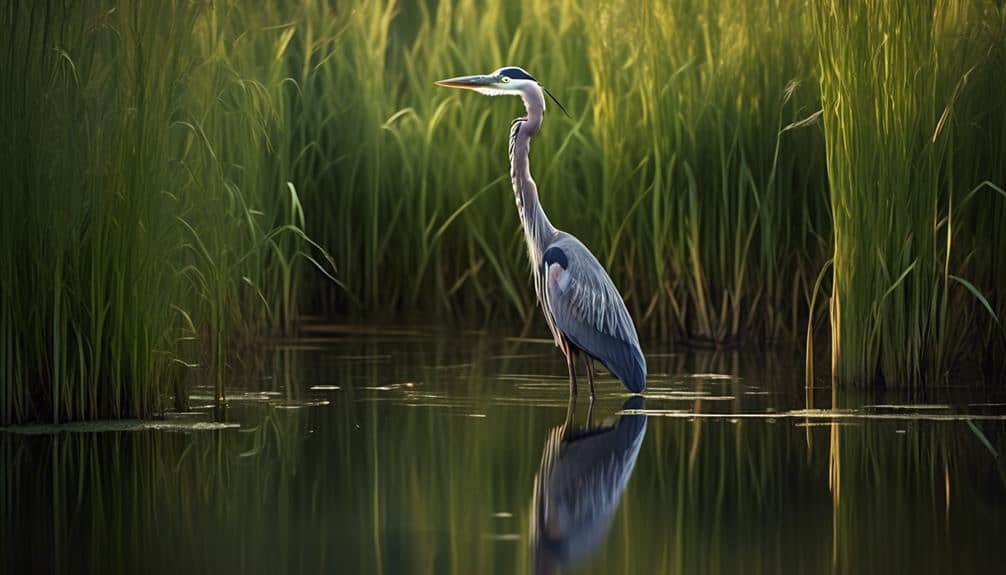
The Great Blue Heron, a majestic and elegant avian species, dominates the wetlands of Iowa with its towering presence and graceful movements. As I watch a Great Blue Heron in its natural habitat, I'm struck by the bird's graceful behavior. With its long legs and neck, the heron moves with an effortless grace, whether walking slowly through the shallow waters or taking flight with powerful wingbeats. Its movements are precise and deliberate, as if every step and every wingbeat is calculated with meticulous accuracy.
The Great Blue Heron's graceful behavior isn't only a sight to behold, but it also serves an important purpose in the wetland ecosystem. As apex predators, they play a crucial role in maintaining the balance of the ecosystem by controlling populations of fish, amphibians, and other small animals. Their presence in the wetlands is an indicator of a healthy and thriving ecosystem.
However, the Great Blue Heron and its wetland habitat face numerous challenges, including habitat loss and degradation. Wetland conservation efforts are crucial to ensure the survival of this magnificent species. By protecting and restoring wetlands, we can provide the Great Blue Heron with the habitats it needs to thrive, and in turn, preserve the delicate balance of the wetland ecosystem.
Red-headed Woodpecker: A Vibrant Visitor in Iowa's Forests
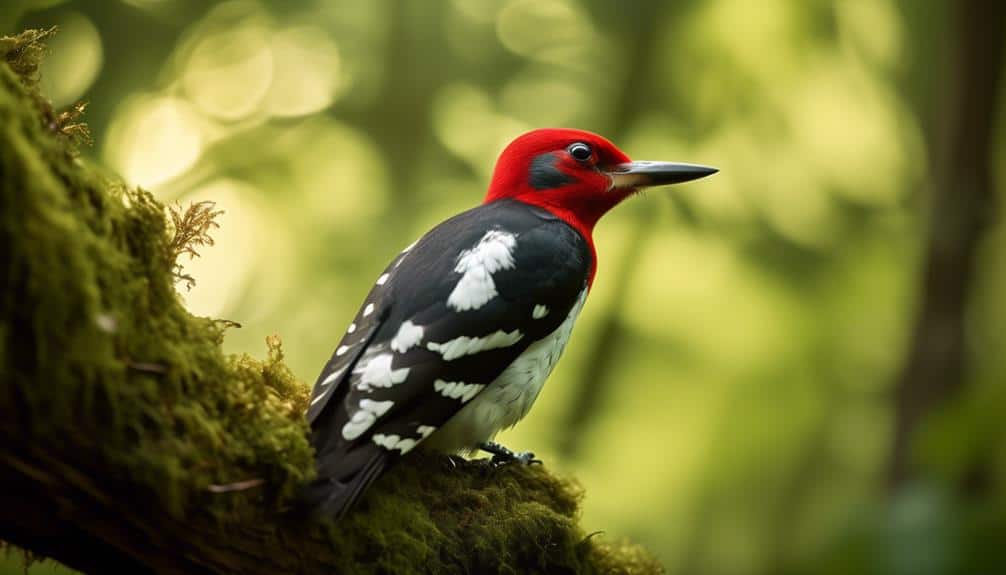
A vibrant burst of red streaks through the Iowa forests, as the Red-headed Woodpecker showcases its striking plumage and energetic presence. This magnificent bird is a true sight to behold, with its vibrant plumage standing out against the backdrop of the forest. Here are some fascinating details about the Red-headed Woodpecker:
- Plumage: The Red-headed Woodpecker is aptly named, as its entire head, neck, and upper body are adorned with a brilliant shade of red. This bold coloration contrasts beautifully with its black wings and white belly, making it easily recognizable.
- Feeding habits: This woodpecker has a diverse diet, feasting on insects, fruits, nuts, and even small vertebrates. It's known for its ability to catch insects on the wing, displaying impressive agility and precision in its hunting techniques.
- Nesting behavior: The Red-headed Woodpecker constructs its nests in tree cavities, often reusing old nest holes or excavating new ones. Both males and females take part in nest building, using their strong bills to chip away at the wood.
- Conservation status: Despite its vibrant presence in Iowa's forests, the Red-headed Woodpecker faces some conservation challenges. Loss of habitat and competition with non-native species have led to a decline in its population. Efforts are underway to protect and restore suitable woodlands for this stunning bird.
Frequently Asked Questions
What Is the Average Life Span of a Bald Eagle in Iowa?
The average life span of a bald eagle in Iowa is about 20-30 years. They have a diverse diet that includes fish, waterfowl, and carrion. They also build large nests in wetlands and follow a migratory pattern.
What Is the Diet of the Eastern Bluebird in Iowa?
The Eastern bluebird in Iowa has a varied diet consisting of insects, berries, and fruits. This diet plays a crucial role in the population dynamics of the Eastern bluebird, as it affects their reproductive success and overall health.
How Does the Northern Saw-Whet Owl Locate Its Prey in the Dark?
The northern saw-whet owl uses remarkable night hunting techniques to locate its prey in the dark. By relying on its acute hearing and excellent vision, the owl can pinpoint the slightest movement or sound made by its prey.
What Is the Migration Pattern of the American Goldfinch in Iowa?
In Iowa, the American goldfinch demonstrates a graceful migration pattern, akin to a river flowing steadily through changing landscapes. Their breeding behaviors are meticulously executed, as they seek out suitable habitats for nesting and raising their young.
How Do Great Blue Herons Build Their Nests in Iowa's Wetlands?
Great blue herons are fascinating creatures that play an important role in wetland bird conservation. Their nesting habits involve building large stick nests high up in trees near wetlands, providing a safe haven for their young.
Conclusion
In conclusion, the birds of Iowa are truly extraordinary creatures, each with their own unique qualities and behaviors. From the majestic Bald Eagle soaring high in the sky to the vibrant Red-headed Woodpecker drumming its rhythm in the forests, Iowa's avian residents are a sight to behold.
Their colors, grace, and hunting techniques are a testament to the wonders of nature. So next time you gaze up at the skies or explore the wetlands, remember that Iowa is home to these magnificent and awe-inspiring birds.


